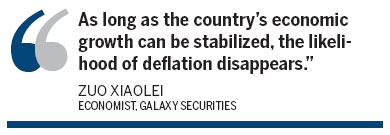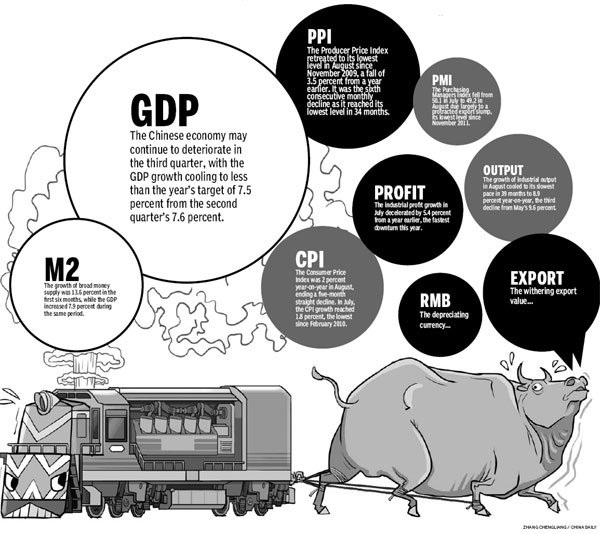Deflation rears its ugly head
Updated: 2012-09-17 07:56
By Chen Jia (China Daily)
|
|||||||||||
|
Average output of China's crude steel stood at 2 million tons a day, with the industry being plagued by excessive production compared with the shrinking market demand. The National Bureau of Statistics reported a lower-than-50 manufacturing Purchasing Managers Index in August. It fell from 50.1 in July to 49.2, its lowest level since November 2011. Anything below 50 indicates contraction. Shi Yan / For China Daily |

Negative figures paint gloomy prediction for China's economy
China's rapidly slowing consumer inflation and falling industrial output prices are a potent reminder to economists of the potential risk of deflation, a sign of recession regarded as worryingly negative.
"Deflation" means a constructive decrease in the price of goods and services over a relatively long term.
Concerns about it started in June when the Consumer Price Index dropped to less than 3 percent for the first time in more than three years.
The annual CPI, a main gauge of inflation, bounced back to 2 percent in August, ending a five-month straight decline, according to the National Bureau of Statistics.
In July, the year-on-year CPI growth reached 1.8 percent, the lowest since February 2010, compared with 2.2 percent in June. That was the first time the figure fell to less than 2 percent in 30 months.
"The Chinese economy is now facing a situation of disinflation, a slow-down in the inflation rate, but not deflation - when the inflation rate falls to less than zero," said Sun Lijian, deputy chief of the Economic School at Fudan University in Shanghai.
It is likely inflation may bounce back soon in the coming months because growth in money supply is high while the development of the economy is slowing, a situation that can lead to excess liquidity, said Sun.
In the first six months of this year, the growth of broad money supply, which is known as M2, was 13.6 percent, while the gross domestic product increased by about 7.9 percent during the same period, data from the National Bureau of Statistics showed.
Sheng Laiyun, an NBS spokesman, said it was impossible for China to face deflationary risks because the economy is developing at a "healthy" rate.
Some economists said that although consumer prices are still increasing, industrial sectors have already been exposed to dangerous deflationary pressures.
The Producer Price Index, an indicator of production output prices, retreated to its lowest level in August since November 2009, a fall of 3.5 percent from a year earlier. It was the sixth consecutive monthly decline as it reached its lowest level in 34 months.
When PPI declined 2.9 percent year-on-year in July, it was a warning that manufacturing companies' income had dropped rapidly, a development that might hold back additional investment in industrial sectors and further drag down the whole economy.
The NBS also reported the growth of industrial output in August, which cooled to its slowest pace in 39 months to 8.9 percent year-on-year, the third decline from May's 9.6 percent, after 9.5 percent in June and 9.2 percent in July.
The faster-than-predicted drop in output prices directly influenced the industrial companies' profitability. In the first seven months of this year total profits of big industrial enterprises declined by 2.7 percent from the same period in 2011 to 2.68 trillion yuan.
Monthly industrial profit growth in July decelerated by 5.4 percent from a year earlier, the fastest downturn this year. Among the 41 industrial sectors, 15 of them have seen profits drop while one sector suffered losses.
The falling production prices and shrinking profits are in line with flagging industrial output, which slowed to 9.2 percent in July, its weakest growth for 38 months, according to data from the national statistics agency.
Market confidence was consequently hit and many global investment institutions downgraded their expectations of industrial growth in the third quarter.
Although it is difficult to say for sure that the world's second largest economy has entered a deflationary era, the PPI is certainly foundering in deflationary territory, said Shen Jianguang, a Hong Kong-based economist at Mizuho Securities Asia Ltd.
Industrial manufacturers may suffer from difficulties across the entire year, with forecasts that both output and profit indicators are likely to be worse in the autumn, according to Yuan Lei, director of the industrial operation department with the Institute of Industrial Economics at China Academy of Social Sciences.
"Fundamental problems in the Chinese economy are starting to show and the downside risk is very hard to control," Yuan said pessimistically.
Uncertainty over overseas demand, retreating governmental supportive policies and tightening property control have all pushed the industrial companies into a chilling environment. However, deeper problems, such as the increase in labor costs and the slumping competitiveness of Chinese business, should be given more attention, Yuan said.
The NBS reported a lower-than-50 manufacturing Purchasing Managers Index in August. It fell from 50.1 in July to 49.2 due largely to a protracted export slump, its lowest level since November 2011.
The decline fueled worries about deflation in the industrial sector that troubled the economy from 1997 to 2003.
The weakening industrial indicators added to evidence that the government's cautious steps of policy stimulus have not yet stopped economic decline, said Xiao Bo, an analyst with Huarong Securities Co.
"The Chinese economy may face a more serious deflationary situation in the future," Xiao said.
With no signals from the government of immediately stimulating growth, worries about slowing economic growth remain unabated.
The Chinese economy may continue to deteriorate in the third quarter, with the GDP growth rate cooling to less than the year's target of 7.5 percent from the second quarter's 7.6 percent, the lowest for three years, according to economists.
The development has delayed the time forecasting for the economy to begin to bottom out from the second half. At least another three or four months are needed to see a rebound when all the industrial indices are currently disappointing the market, economists said.
The People's Bank of China has cut benchmark interest rates twice since June in order to boost market liquidity and encourage bank lending.
The eased monetary policy appears to have been insufficiently strong to create steady industrial growth in July and August.
UBS AG lowered the predicted whole-year GDP growth rate at the beginning of September from 8 percent to 7.5 percent after recent economic activity remained weak as export growth slowed.
"The policy support was not as rapid or aggressive as previously envisaged," a report from UBS stated. "Although local governments seem eager to increase public investment, they have not been supported by a concerted central government effort or bank financing."
Zhu Haibin, chief economist in China with JPMorgan Chase & Co, said that stabilizing economic growth is much more important in the short term. "The central bank still has some room to ease monetary policy, including cutting interest rates and lowering the reserve requirement ratio," he said.
He added that September would be a good time to cut interest rates again.
It may be very stressful for policy makers to adopt stimulus packages soon even though the signs of decline are getting stronger.
The gradual slowdown in the economy is not as sudden as the collapse in 2008 and any major policy easing may lead to a quick rebound in property sales and prices that will take away the government's efforts over the past two years.
"We expect a somewhat intensified implementation of the existing policy measures, including an increase in infrastructure investment, but a major new stimulus is unlikely unless the economy worsens sharply," said Wang Tao, chief economist in China for UBS.
In September the Chinese government approved 25 subway lines and 13 highway projects nationwide within a week. Nomura Securities Co estimated total investment for the infrastructure projects will exceed 1 trillion yuan ($157.48 billion).
That may be an effective method to boost fixed-asset investment and then drive up the whole GDP later this year, economists said.
"As long as the country's economic growth can be stabilized, the likelihood of deflation disappears," said Zuo Xiaolei, an economist with Galaxy Securities.
chenjia1@chinadaily.com.cn

(China Daily 09/17/2012 page13)
Today's Top News
President Xi confident in recovery from quake
H7N9 update: 104 cases, 21 deaths
Telecom workers restore links
Coal mine blast kills 18 in Jilin
Intl scholarship puts China on the map
More bird flu patients discharged
Gold loses sheen, but still a safe bet
US 'turns blind eye to human rights'
Hot Topics
Lunar probe , China growth forecasts, Emission rules get tougher, China seen through 'colored lens', International board,
Editor's Picks

|

|

|

|

|

|






